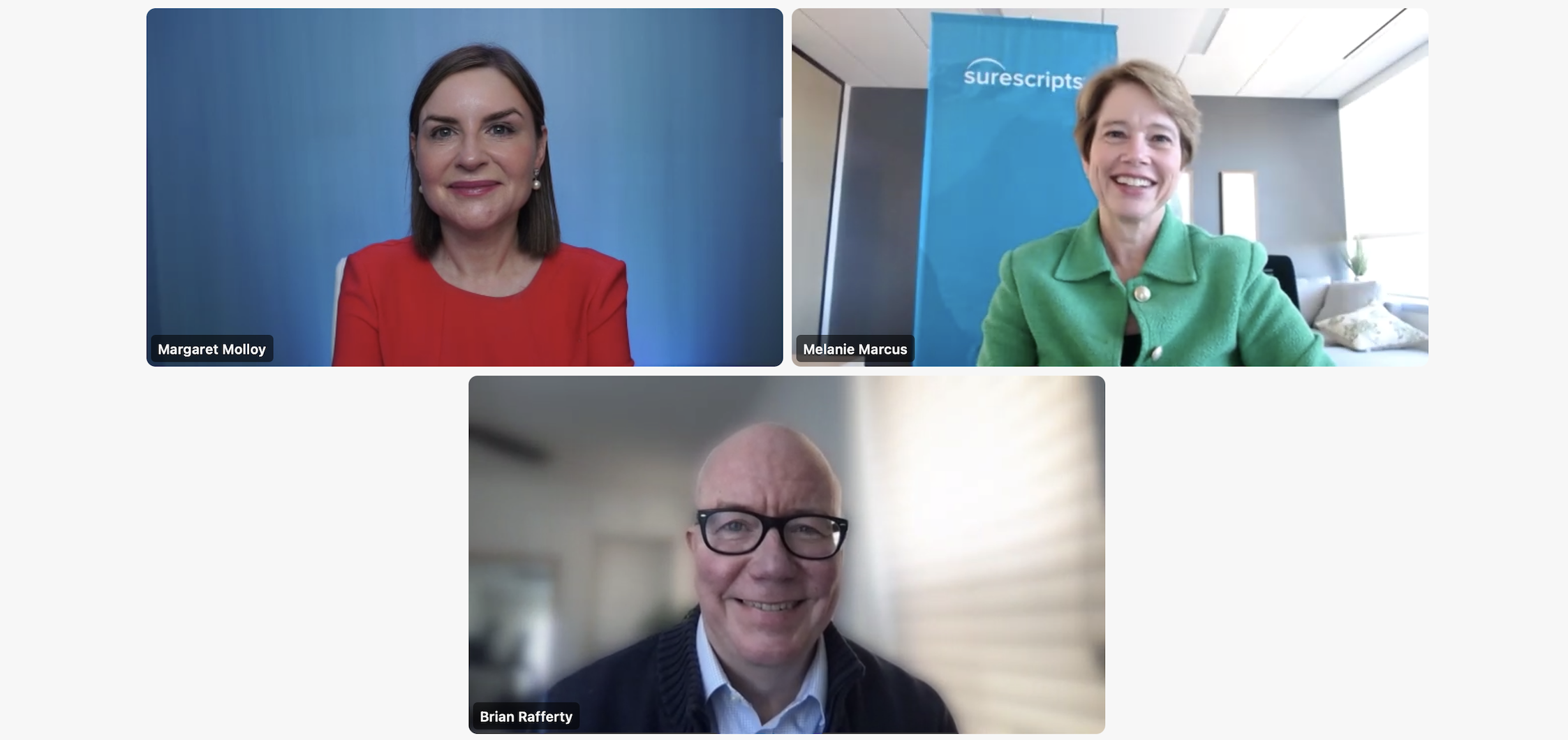In our Unlocking Brand series, a CMO joins our branding experts to explore an exceptional brand-building case. In this installment, “Brand as a strategic business asset,” our Global CMO, Margaret Molloy, moderates a conversation between Melanie Marcus, CMO, Surescripts, and our Global Director of Business Analytics + Insights, Brian Rafferty.
The conversation explores some of the most frequently asked questions by CMOs, especially B2B CMOs, on such themes as how to manage brand as an asset, how to extend perceptions beyond the original offering, the role of research in creating clarity and how to achieve C-level alignment.
The conversation has been edited for brevity and clarity. For the complete conversation, head over to Apple Podcasts or Spotify.

Margaret Molloy: Melanie, when you commenced your role in 2017, what was the context of the Surescripts brand?
Melanie Marcus: At the time, Surescripts had just finished building electronic prescribing across the country, and that’s what Surescripts was known for. It had also just finished launching several new products beyond electronic prescribing that would exchange clinical information, medication information, etc., across the healthcare ecosystem in the United States. We needed to be known for more than electronic prescribing in order for those to be successful.
Margaret Molloy: That’s the heart of this case study and that classic question that Brian and I, and our colleagues, get all the time: From a brand that’s known for excellence in one area, how do you extend that perception? Brian, how do you, in the context of Surescripts, think about what’s the job to be done by a brand in that setting?
Brian Rafferty: Brand has many jobs. But one of its first jobs on which to build at these points is to get people in the consideration mindset, if you will, for what the company offers. Job number two is that brand is the way to ensure that the future course is set in the direction you want it to go and to align everyone to that direction. Then, ideally, all decisions are made with that direction in mind, “What does the brand stand for? What should the brand stand for going forward? How are we going to make that happen?”
Margaret Molloy: So, pick up that point, Melanie, regarding the brand in action. Can you illustrate that for us? The implication is that it’s more than words and pictures, and it sounds like a strategic asset.
Melanie Marcus: Brand is reputation, and it’s what’s in the room before you get there. It’s more than if your reputation is good or great. It’s, “Is it what you mean it to be?” Our purpose is “Surescripts serves the nation through simpler, trusted health intelligence sharing in order to increase patient safety, lower costs and improve the quality of care.” Is your purpose in the room before you get there? If it is, then your path, once you get to the room and you’re working with customers or prospects, is a lot easier than if you go into the room and have to build or defend against something that is not necessarily what you want. You don’t want to be in a transactional business; you want to be in a relationship business. If you’re in a relationship business, a brand reputation is a part of what you’re known for before you enter that room and why someone picks up the phone to call you when they have another business issue that you might be able to solve.
Margaret Molloy: Critical to advancing that mission is CEO and C-level alignment among your peers. Talk to us about how you’ve continued to grow that through your tenure at Surescripts.
Melanie Marcus: The first thing that was important to me in looking at the job at Surescripts was that the senior team and the CEO were very much on board with brand as an important asset. If I had come into an organization that was just about lead generation, brand may not have been on the table and it would’ve been a much steeper hill to climb. The second important thing is that if you’re working on big brand work, you want to choose an agency that will stay with you for a long time. That’s why we selected Siegel+Gale as our brand experience agency. This is not just a year—this is a long time, part of who the organization is—so you want to ensure you have an agency you can present to your executive team or your CEO.
Margaret Molloy: Brian, what have you observed as you work with Melanie in this process around C-level alignment?
Brian Rafferty: One important thing is having them all feel like they are the contributors who are truly building the brand. Melanie has done this well: not bringing everyone to the table in a way where they feel like they’re being talked to but where they add value to the conversation. At Surescripts, I’ve observed that every senior executive has seen these opportunities to think about and talk about brand as being this moment of, “Okay, I get to step away from my immediate concerns and immediate role and get to think strategically about the future of the organization, where it should go, and what the challenges are.” That means that what you do from a brand standpoint will be effective because everybody is aligned and feels like they have a stake in its impact and importance.
Margaret Molloy: Melanie, now that you’ve had the benefit of five years of this brand work and more on the horizon, what excites you, what continues to excite you about Surescripts and your brand programs there? And what’s your advice to other CMOs who are inspired by your journey and the work you’ve done to build the brand?
Melanie Marcus: It’s an honor to work in an organization where you believe in the purpose. I’m also excited about employee engagement. It’s about realizing this brand and bringing all employees into the activation. My advice to CMOs is this: make sure you have a like-minded organization. Building a brand is a lot of work, and it may not pay off to start an organization that isn’t quite there. But once you’re there, do not expect the whole thing to be built in a year. Bite it off in small pieces that are aligned with where you are as a business at that point, and eventually, it’ll evolve.
Margaret Molloy: Brian, similar question to you: what are your observations working over the five years with Surescripts that may inform lessons for other CMOs, best practices, things to avoid, etc.?
Brian Rafferty: What I’ve found most pleasurable and fulfilling working with Melanie at Surescripts is you feel like the work is having an impact. Things start changing, and you see the impact happening—it’s not abstract; rather, it’s tangible and real. And don’t just try to do some huge thing and do everything all at once. I think it is about making that connection. Think about the business and what it needs. And then, ask yourself how you can craft an initiative that will both deliver some long-term benefits from a brand-building standpoint.


